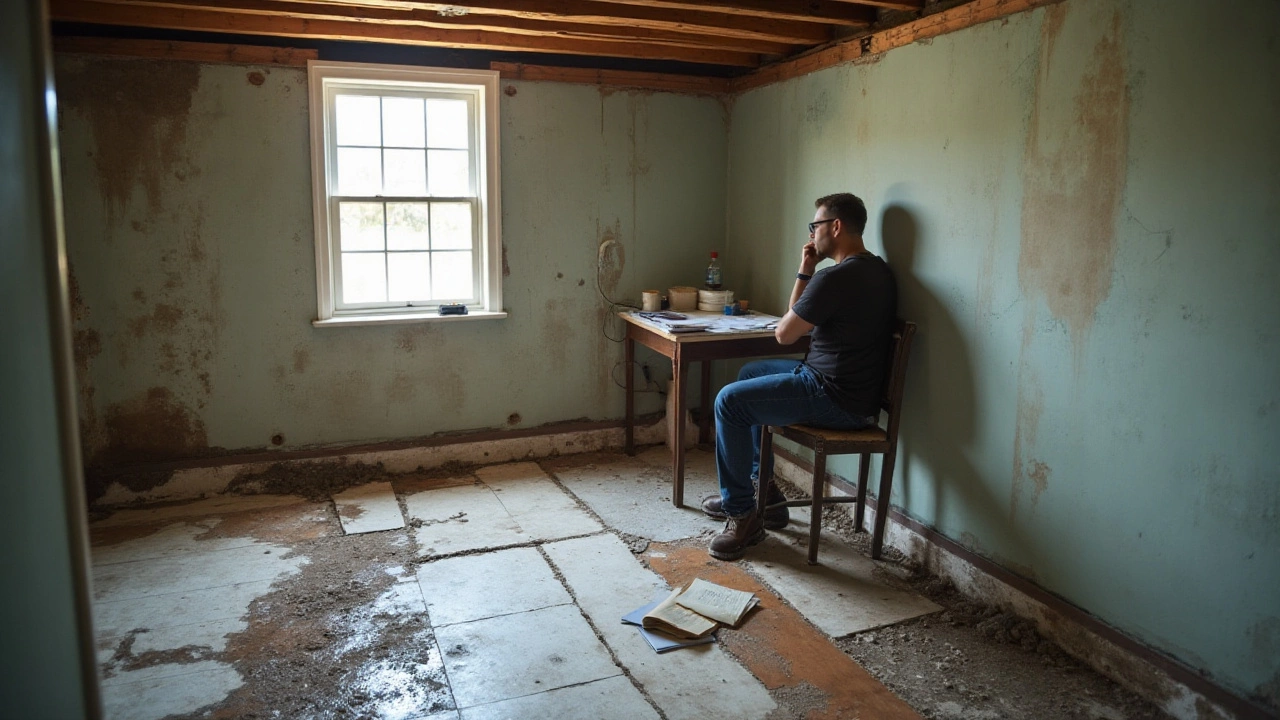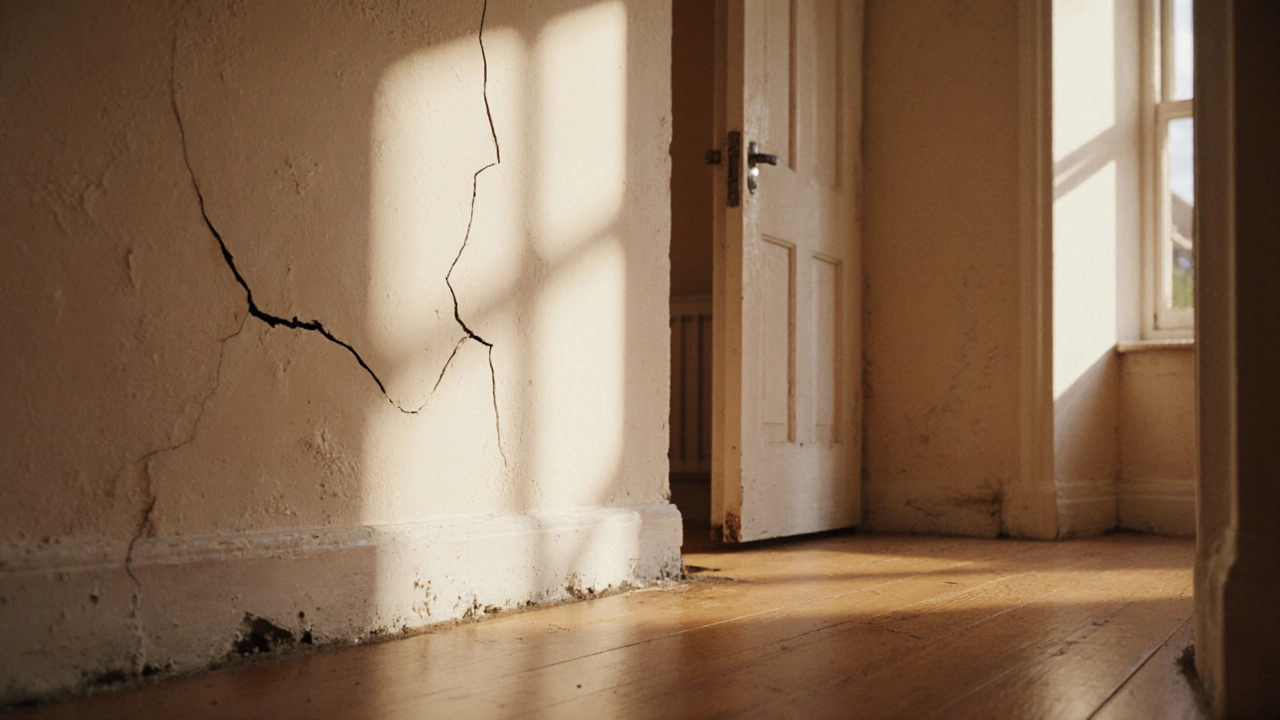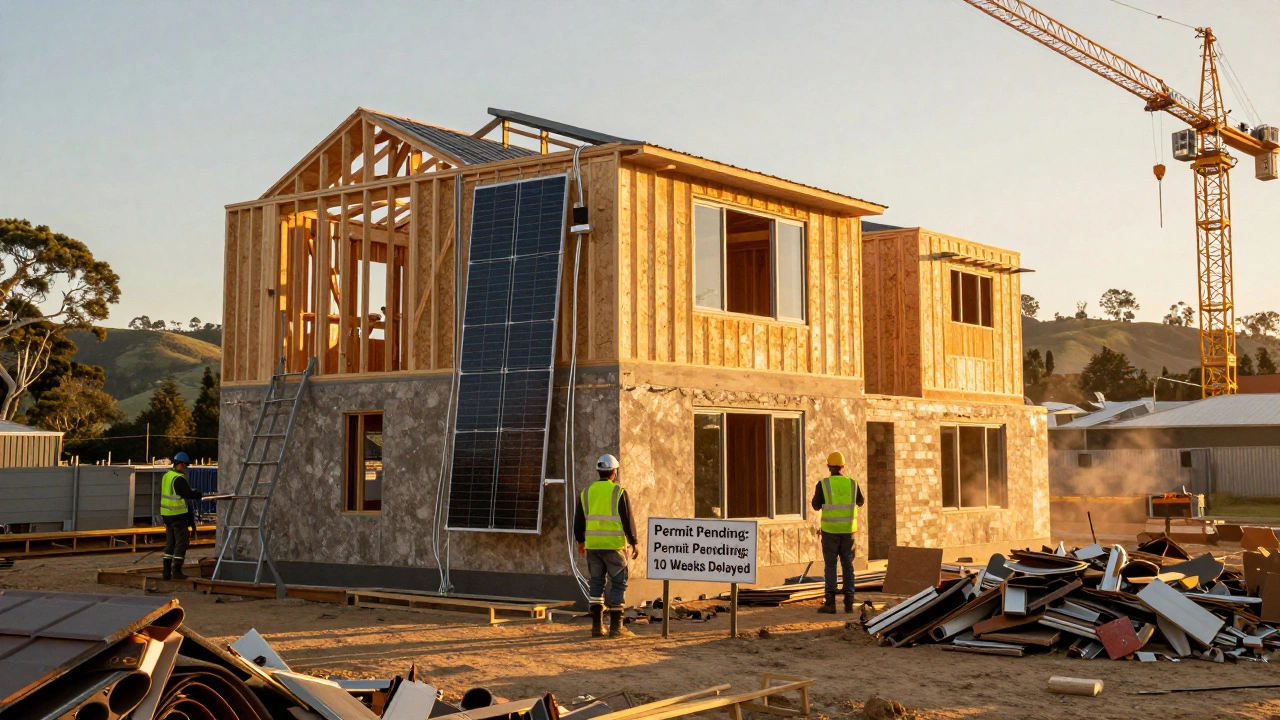Discovering foundation problems in a potential new home can be unnerving, especially when visions of your future life there dance in your mind. Many of us have been drawn in by the allure of a perfect, cozy retreat, only to uncover that it’s experiencing some structural shivers at its base. But before anyone hits the panic button, it’s pivotal to pause and evaluate what these issues truly represent.
Foundation problems aren't automatically deal breakers, but they do demand your attention. They can range from minor cracks that are easily monitored and repaired, to more serious shifts that might threaten the home's very structure. Homebuyers need to arm themselves with as much knowledge as possible to navigate these troubled waters confidently.
- Identifying Foundation Issues
- Evaluating the Risks
- Remediation Options
- Negotiation Strategies
- Making the Final Decision
Identifying Foundation Issues
Foundation issues can present a formidable challenge to potential homebuyers, but identifying them isn’t always straightforward. Armed with a keen eye and some helpful knowledge, anyone can spot the telltale signs. Initially, look at the structure’s exterior. Cracks in the foundation are perhaps the most overt indicators. Vertical cracks may not be alarming, but horizontal ones should ring alarm bells as they could suggest serious pressure against the walls. Beyond the foundation itself, check for gaps around windows and doors, as these might signal that the house has shifted.
Inside, take a good look at the walls and ceilings for cracks or bulges. Surprisingly, the humble door can tell a tale about possibly harmful home movements. Are they sticking or not latching properly? Does the floor beneath your feet seem uneven or slope in strange directions? These are clues that shouldn’t be shrugged off lightly. According to a noted home inspection expert, "A sagging floor might not just be a simple sign of old age; it often hints at underlying structural damage that needs addressing before it escalates."
Pay particular attention to basements and crawl spaces. Dampness in these areas, often observed via mildew growth or a distinctly musty smell, could point toward water infiltrating the foundation, which can lead to foundation problems down the road. It's not just water infiltration either; poor drainage around the house might be undermining the soil, slowly impacting the structure’s stability. Structural beams that have shifted or show signs of rot are also significant indicators of potential issues.
Sometimes, the foundation's troubles aren’t visible to the naked eye. That's why it’s crucial to rely on an expert evaluation when there’s any suspicion. Seasoned professionals employ sophisticated tools to gauge a home’s levelness and stability, noting any shifts or weaknesses that an untrained eye might miss. This kind of thorough examination is invaluable for assessing hidden but significant risks, which might not always manifest in obvious wear and tear.
Understanding these signs empowers buyers to make informed decisions regarding real estate decisions. Even seasoned homebuyers can find themselves uncertain when confronted with potential foundation issues. Therefore, knowledge acts as their strongest ally, mitigating second guesses about whether a property truly holds promise or peril. Before committing to any home purchase, ensuring all existing and potential foundation issues are fully understood provides a comforting assurance and a step towards securing a sound investment.
Evaluating the Risks
When considering a home with foundation problems, weighing the risks is as essential as understanding the price tag attached to any needed repairs. Unseen beneath the surface, these issues can undermine not just the structure of the building but also its market value and insurability. Now, many might wonder whether these problems can be merely cosmetic or if they resonate deeper, indicating potential calamities. Deep foundational shifts can result in uneven floors, cracked walls, or even issues with doors and windows that suddenly won't close properly. These physical signs mirror the invisible battles raging beneath your feet—the pressure, the settling, sometimes even water damage.
The scale of potential damage runs wide. A hairline crack in a basement wall, for instance, might not pose much of a threat singularly, but an entire web of such cracks could suggest ongoing movement and stress within the foundation. More alarming issues could include significant settling or an unbalanced lift that may cause what is often termed the "descending domino effect." This drives the idea that small foundational alterations, if left unchecked, might gradually lead to drastic structural failures. The relevant importance here isn't necessarily about identifying each crack but understanding the warning signs they collectively present.
Not only are structural dangers a significant concern, but financial implications must also be factored in. Homeowners might find difficulty securing a traditional mortgage on a property with significant foundation problems. Insurance companies may shy away or apply hefty premiums. It's important to remember that remediation isn't merely about patchwork repairs but undergoing substantial renovations that could demand serious financial planning. According to a report by HomeAdvisor, the average cost to repair a foundation is about $4,500, though this price can sharply rise depending on the severity and location of the damage.
Making an informed decision about purchasing a property facing such issues involves foresight and sometimes the view of experienced inspectors. Many potential buyers seek the insight of structural engineers, ensuring they have an independent perspective on what can be realistically expected in terms of both remediation and long-term prognosis. A potential homeowner once said, "Every crack tells a story, and it's vital you have someone who can read the chapters before you make a decision." Talking to past homeowners, chatting with neighbors, or spending time in local real estate forums might uncover additional unreported problems or previous attempts at repair. These are invaluable resources for your decision-making process.
Ultimately, evaluating these risks involves balancing both your heart and your head. The decision touches upon practical economics and the inherent human dream of owning a secure and safe home. No two foundations are the same, and an attentive, thoughtful approach ensures that even if your dream home seems a little shaky, you have the clarity and confidence to address or walk away from any problems it might present.

Remediation Options
When faced with a home suffering from foundation problems, understanding the remediation options becomes crucial. Addressing these issues tends to be neither simple nor cheap, but knowing your options can turn a potential nightmare into a manageable project. The first step generally involves a thorough inspection by a qualified structural engineer. This professional will assess the extent of damage, identify the root causes, and suggest potential treatment plans. Depending on the complexity, these assessments can vary significantly in cost, but they are an essential investment for any potential buyer.
One popular method for correcting structural issues is underpinning. This technique involves strengthening or deepening the foundation by extending it beneath the surface layers, most commonly through concrete or steel piers. This approach can effectively stabilize homes suffering from significant settling or shifting. Another solution, especially for minor cracks or leaks, is epoxy or polyurethane injections, which seal and reinforce without intensive construction work. Each of these methods has pros and cons in terms of cost, disruption, and long-term effectiveness.
For houses experiencing seasonal movement because of soil conditions, mudjacking might be a worthwhile consideration. This involves pumping a grout mixture beneath the slab to lift and stabilize the surface. It's less invasive than other methods, making it a favorite for those looking to minimize disruption. Structural damage caused by inadequate stormwater control could also be alleviated by improving drainage systems around the property. Often, simple interventions like grading or installing French drains prove highly effective in redirecting water away from the foundation.
Cost Considerations
Remediation costs can vary widely based on the severity and scope of the repair needed. It’s important to obtain several quotes from reputable contractors to ensure you're getting a fair price. A typical underpinning project might range from $5,000 to $15,000, but more complicated issues could escalate into tens of thousands of dollars. Given these expenses, it's practical for buyers to negotiate with the seller to share remediation costs or adjust the sale price accordingly.
| Remediation Method | Average Cost | Typical Use Case |
|---|---|---|
| Underpinning | $5,000 - $15,000 | Severe settling or shifting |
| Epoxy Injection | $500 - $2,500 | Minor cracks and sealing |
| Mudjacking | $600 - $1,800 | Lifting sunken slabs |
| Drainage Improvement | $1,000 - $5,000 | Mitigating water issues |
"Foundation repair might be costly, but it is the financial lifeline that secures the investment in your home," says a renowned structural engineer. This emphasizes the importance of taking these issues seriously while weighing the financial implications.
Considering these options thoughtfully can lead you down the path to protecting your investment while ensuring long-term safety and stability of your property. Exploring remediation possibilities not only saves costs in the long run but can also increase the overall value of the home, making your real estate venture a truly rewarding endeavor.
Negotiation Strategies
Negotiating the purchase of a home with foundation problems can be a delicate dance, one where preparation and information are the keys to securing a successful deal. First, having a professional inspection report is crucial. This document lays the groundwork for any discussions with the seller by detailing the specific issues and providing estimates for potential repair costs. Not only does it arm you with undeniable facts, but it also ensures that you are speaking from a position of knowledge and not conjecture. Remember, sellers often expect negotiations once foundation issues are disclosed, and presenting this report helps solidify your requests for either a lower price or assistance with repairs.
Many times, sellers are willing to negotiate because they understand the implications that structural damage can have not only on the price but on the saleability of their property. When beginning negotiations, it might be beneficial to propose that the seller covers the cost of repairs before closing, or to request that these costs are factored into the final sale price. However, it's essential to have realistic expectations—some sellers might only agree to partial contributions or a reduction in price that reflects the projected repair expenses.
Approach the conversation from a place of empathy as well—understanding the seller’s perspective can foster goodwill. They might have had no idea about the issues until the inspection and could be feeling just as overwhelmed. Establishing a collaborative rather than combative tone can work wonders in these discussions. It's important to remain flexible and open to various outcomes, understanding that each scenario is unique. By doing so, you might discover creative solutions, such as having the sellers carry out some repairs themselves, which may be less costly for them and more feasible in the short term.
Although negotiating can be daunting, many buyers find success by being patient and using tools like comparable sales. Point out other similar homes in the area that are structurally sound and how their prices compare. This market data can strengthen your position, showing that reducing the price due to foundation issues is not just fair, but necessary to align with the current market value. It's also advised to consult with a real estate agent experienced in handling properties with such issues, as they can offer invaluable insights and recommendations.
"The secret to negotiating a win-win outcome when it comes to properties with issues is to always aim for a fair deal for both parties," says a seasoned real estate consultant. "Understanding what's at stake for both buyer and seller leads to more successful negotiations."
As a part of your strategy, keep in mind the potential for future savings. Sometimes additional concessions, such as a home warranty that covers future structural repairs, could be negotiated. This ensures long-term security and peace of mind for a buyer who decides to go ahead with purchasing a property with existing issues. Coupled with prudent negotiation, such proactive measures further justify proceeding with the purchase.

Making the Final Decision
When faced with a house that has foundation problems, determining whether to commit or walk away is a pivotal choice. It’s not just about bricks and mortar; it's about the substantial investment both emotionally and financially. The dilemma often boils down to weighing the potential benefits against the risks and costs associated with the repair and future value of the property. Knowledge is power in this scenario, and understanding the full breadth of what you're up against can make all the difference.
First, consider the scale and nature of the foundation issues. Are they minor, such as small hairline cracks that may not require immediate attention, or do they signify more severe structural damage needing urgent and potentially costly repairs? Consulting with a certified structural engineer who can offer a detailed assessment is invaluable. Their expertise often helps narrow down the complexity of the repairs. As home inspectors might say, "What looks significant to the untrained eye may simply be regular wear and tear."
Next, reflect on your financial capability and readiness to deal with these issues. Foundation repairs can range from minor fixes with a few thousand dollars to extensive overhauls soaring beyond tens of thousands. It’s crucial to get multiple quotes from reputable contractors to avoid any surprises. During this phase, one's ability to negotiate with sellers can make a significant difference. You might be able to negotiate a lower price or ask the sellers to cover repair costs. Knowing the market can empower you to drive a firmer bargain.
Beyond money, consider the time and inconvenience involved in repairs and living arrangements. Repairs can take weeks or even months, depending on the severity and scope of the work required. This could mean temporary relocation or enduring some lifestyle disruptions until completion. Such considerations should weigh heavily in your decision-making process. Imagine planning your family's daily life amid the clatter and disruption of construction work; this is a reality you might have to brace for.
Real estate decisions often hinge on your long-term vision. Are you seeking a forever home, or is this an investment property you plan to flip? Understanding your ultimate goals can strongly influence whether this home's foundation issues are worth tackling. Some buyers relish a challenge and perhaps have skills or resources to mitigate such problems efficiently, while others may prefer to seek a more turnkey solution.
To solidify your decision, create a comparative analysis of both scenarios: purchasing with repairs and choosing an alternative property without such issues. With factors like location and potential market appreciation thrown into the mix, the right decision often becomes clearer. Choose based on collected facts, not just emotional drive. In some cases, foundation issues, when properly addressed, can result in a home becoming even more valuable than initially perceived.
"The secret of making good decisions is to make as few bad ones as possible," a lesson any homeowner should heed, as succinctly quoted by renowned financial adviser Joe Gardener.








